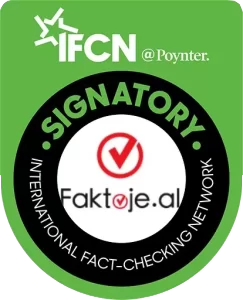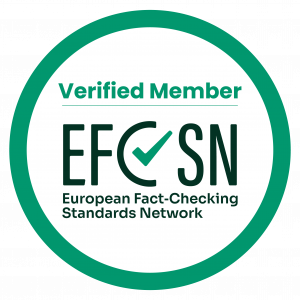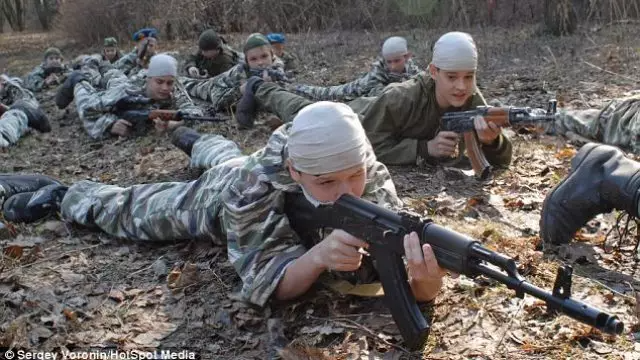Disagreements on the issue of license plates on the Serbia-Kosovo border fed the Albanian-speaking media, especially in recent months, with news that war was on the brink. Faktoje brings an analysis on the untruthfulness of these news, as was the one about September 1st, even though the inciting tendency of Serbian politics, especially in the North of Kosovo, has not been lacking. The fact is that despite the inciting statements, diplomacy has had the last word by ‘discouraging’ the war scenarios.
Barbara Halla
War bells ring in the Albanian and Serbian media every time the governments of Serbia and Kosovo (especially the latter) announce the implementation of a new law, which aims at movement or exchanges between the two countries.

Source: Gazeta Shqip

Source: Syri.net
The most recent case was that of identity cards. In June 2022, Albin Kurti’s government passed a law for further reciprocity measures with Serbia. According to that law, as of July 1, Serbian citizens with Serbian documents would be obliged to provide identity cards from Kosovo when entering the territory of the latter. This also included Serbian citizens of northern Kosovo, who very often continued to carry Serbian license plates and documents despite the fact that they live in Kosovo. This decision of the Kosovar government went in parallel with identical policies put into practice by the Serbian government for travelers from Kosovo.
The Government of Kosovo announced its plans at the beginning of June, with the aim of implementing this measure on July 1. The harsh reactions of Serbian President Aleksandar Vučić and his appeals to the Serbian population of Kosovo incited people in the north, and with the intervention of the USA and the European Union, this decision was postponed until September 1. In the following two months, both sides met in Brussels where on August 27 they reached a positive agreement for Kosovo: from September 1, travelers from Kosovo will not be obliged to present Serbian ID cards at the border. As a consequence, Kosovo would not implement the law on identity cards in June of this year.
However, in the period between the day when the agreement was reached and the day of implementation (i.e. September 1st), alarming messages were not lacking in the Albanian-speaking media.

Source: Bota Sot
Even on the evening of August 31st, there were news reports about military exercises on the Serbian-Kosovo border which were considered dangerous. This was even after the Serbian Ministry of Defense issued a preliminary statement explaining that these exercises were routine and took place every year.

Source: Gazeta Tema
But the morning of September 1st found the borders between Kosovo and Serbia quiet. Reports from the field in media such as Radio Evropa e Lire or Klan Kosova showed that the change was made immediately and mostly without problems. Another conflict foretold, which did not turn into reality.

Source: Klan Kosova

Source: Radio Evropa e Lirë
A war forewarned
News that Serbia and Kosovo are on the brink of war is not a new phenomenon. There is a relatively long history of the situation described above: the Kosovo government implements a new law, Serbia reacts, the media talks about armed conflict or even war, while the parties are quickly sent to Brussels for dialogue. Various agreements are reached, some more definitive than others, and bloodshed subsides. Even in the case of inconclusive agreements, certain postponements are still made and the situation rarely escalates, and so far it has never resulted in war.

Source: Gazeta Tema (News of January 15th, 2017)
A concrete example of the above scenario occurred in September 2021, when the Kosovo government decided to require Kosovo license plates for Serbian cars. The situation worsened right away: Vucic led the army to the border with Kosovo and called on the Kosovo Serbs to resist. Several registration offices in the north of Kosovo were destroyed by improvised explosive devices and the situation was restored only after a 6-month agreement was reached between the parties in Brussels. When the agreement reached its April expiry date, it was extended until the next meeting in the Belgian capital.
In these cases, there were many media that fell prey to Vucic’s rhetoric, reading in his actions the signs of a war that had been announced and was inevitable.

Source: Pamflet
However, the media writing about possible armed conflicts between Serbia and Kosovo are not entirely unfounded. In fact, they are often following the messages issued by the respective governments which speak of an escalation of the situation (in the case of Kosovo) or of a strong reaction (in the case of Serbia). Both sides have accused the other of being willing to create situations that provoke war, which are then covered by local and regional media even when the consequences are negligible and not at all violent.

Source: Euronews

Source: Gazeta Shqip
In the case of Serbia, President Aleksandar Vucic often uses the war as a threat to the actions of the Kosovo government. These threats have increased since the coming to power of the government of Albin Kurti, which has a strong policy focused on the recognition of Kosovo’s independence. It is considered more important than dialogue for the normalization of relations, which in some cases requires concessions that undermine this independence and its integrity. The request for the recognition of license plates and identity cards issued by Kosovo is not just a matter of logistics: in certain aspects, it constitutes a recognition of the legitimacy of documents issued by Kosovo as an independent state.
Both in the case of September 2021 and the summer of 2022, Vucic’s threats proved empty. Undoubtedly, he was ready to bring tanks and warplanes to the border with Kosovo, as well as to threaten peace in the country through the mobilization of Serbs in the north of the country. However, the results were the same. A BIRN investigation has shown that in the last two years, Vucic has often spoken about the fact that Serbia is ready to react to protect the borders, or has made other propaganda statements against the Kosovo government. But none of his threats, or catastrophic predictions, have turned out to be true.
The role of KFOR and Peace in Kosovo
On June 9th, 1999, Serbia signed the Kumanovo Agreement that ended the Kosovo War – after more than 18 months of fighting, over 8,600 Albanians killed or missing, and the displacement of 90% of the Kosovo Albanian population. Besides, this agreement contains two points that safeguard Kosovo’s security: it defines a security zone of 25 km from the air and 5 km from land. Serbian forces are not allowed to cross this line without the permission of KFOR, NATO’s peacekeeping force in Kosovo. Moreover, KFOR itself is authorized to use force in cases where the peace of the area is in danger. Even though Kosovo is not yet part of NATO, an attack on it would bring into action the NATO forces that are stationed in Kosovo precisely to maintain peace.
As Una Hajdari, a journalist who is an expert in the issues of the Western Balkans and those of Kosovo-Serbia relations, has explained, there are no shortage of tensions in the north of Kosovo. However, they are not signs of war, even though Russia may have an interest in Serbia, or Vučić uses Kosovo Serbs for his own political interests. The reality is that so far, all technical issues – even those without a final solution – have ended up at the Brussels table and not in armed conflict. Serbia, and especially Vucic, are more than aware that an invasion of Kosovo could not happen overnight, considering the presence of KFOR on the border.
*This content is produced as part of the regional initiative Western Balkans Anti-Disinformation Hub






